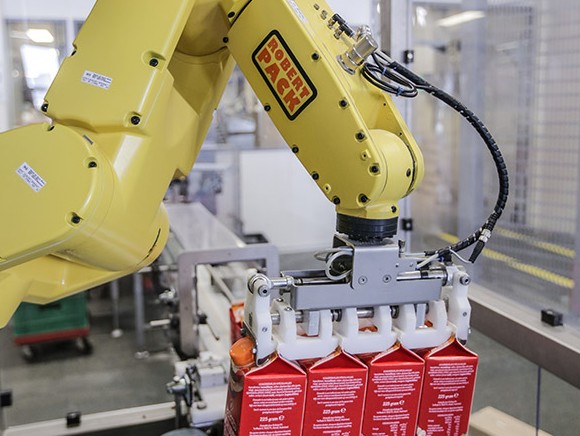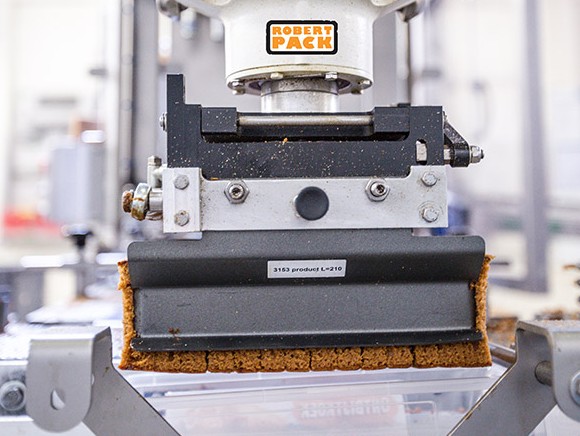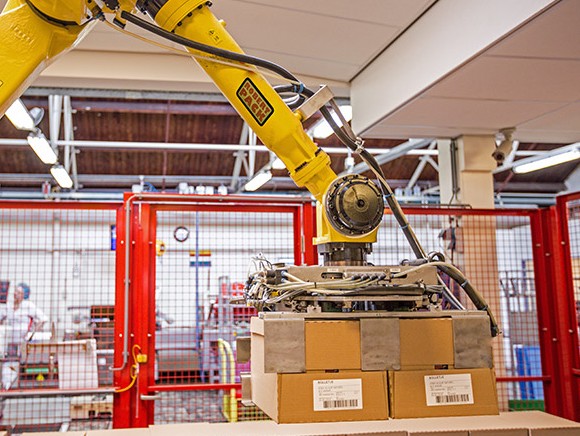
Holding on to its products’ tradition of craftsmanship while also being recognised for innovation and expressiveness – that’s what Bolletje demonstrated it had been able to do last year when it won the FNLI Brand of the Year Award. The Dutch manufacturer of rusks, crackers, cakes, biscuits and a whole range of snacks is not only innovative in terms of its product range, but is also investing heavily in its factories in order to continue to guarantee its quality and competitiveness.
Bolletje’s manufacturing facility in Heerde dates back to 1920, when the firm was established, at that time as the ‘Stoom Koek en Beschuitfabrieken’, by the Van Ark family. The impressive historical building on Zwolseweg is a good fit with the traditionally manufactured bakery products that won Bolletje the Brand of the Year award in 2015. But that heritage also presents the firm with a large number of challenges. For example, there’s a robot that has to manoeuvre its way carefully just beneath the rafters of the building in order to place the cooling racks containing freshly baked spiced cake onto the conveyor above. The robot is fitted with grippers that have been specially developed by Robertpack to enable it to hold the racks at an angle and turn them in such a way that the action can be completed within the tight space.
The robot that moves the cooling racks is one of the four Fanuc robots in use at Bolletje in Heerde. “We were very early in deploying our first robot, for palletisation,” says Paul Borreman, head of the maintenance department at the factory in Heerde. “When it was time to replace it, we went in search of a partner who could use that robot as the basis for developing an application for us so that we could switch between different products easily. We found that partner in Robertpack from Zwolle, a company that has since worked with us on a whole load of projects. They are not far away, which is useful in terms of service. But above all, they take a proactive approach to always devise the most suitable solution.”
At the time, the decision for Fanuc was made by Paul Borreman himself. “I wanted a robot that looked nice. Not one of those palletising robots with a large external arm, but a nice, hygienically designed robot that is suitable for use in the food industry. We have a broad product range which is why we also wanted a flexible robot that could be adapted easily. The robot handles a huge amount of differently shaped packaging boxes, with a different pallet pattern every time. With that in mind, Robertpack developed a gripper that can cope with that level of variation and designed a control interface with a simple user menu from which we can select the products and pallet patterns.”

The factory shuts down twice a year for maintenance. “Robertpack checks that all the mechanical parts are working and takes care of the maintenance for the complete system. The robots systems are very durable machines that have not given us any problems so far,” says Paul Borreman. That is one reason why the Fanuc robots have since been chosen for other projects. There is the robot that moves the cooling racks, which – just like the palletising robot – is a FANUC M-710iC/70. The algorithm controlling the robot ensures that enough racks are kept in circulation between the oven and the cooling tunnel at all times. The robot moves all the other racks to and from a buffer area as necessary. That activity used to be performed manually, which was a very challenging job from an ergonomic perspective, but the intelligently controlled robot has no problem doing it and works three full shifts non-stop. Once the spiced cake has been sliced, a delta robot – the FANUC M-3iA – places the slices in a tray or blister pack. A robot was also added to the line where the ‘Schuddebuikjes’ (tiny ginger-flavoured sprinkles) are packed into small boxes. Working with four small boxes at a time, an LR Mate scoops them into an outer box – the scooping movement is necessary because the box is a fairly tightly fit and the robot would otherwise damage the cardboard. The robot is also positioned at an angle to be able to reach deeply into the outer boxes.
The numerous automation projects at Bolletje are part of the company’s strategy to focus on quality and competitiveness. The company’s many product innovations also mean that the production process must be flexible enough to adapt to the market needs quickly. The use of robots fits into this wider picture. “The Fanuc robots are durable. While that’s important for us, the application that is built around them is equally important, if not more so,” comments Paul Borreman. “In Robertpack, we’ve found a partner who helps us to think up ideas and supplies total solutions.”

“We get deeply involved in the customer’s processes in order to devise tailor-made solutions,” says Klaas Zonnebeld, account manager at Robertpack. “The grippers that are used in the various applications have all been designed by us in line with the specific tasks that the robots are required to perform. The control interfaces above the robots are also custom-made so that the operators can control them in a very user-friendly manner, just as they themselves see the processes.” When developing projects, Paul Borreman always tries to involve as many people as possible – including the operators. “That gives everyone co-ownership of the projects and helps to foster acceptance. It very much revolves around communication and collaboration – and that’s something that we’ve built up over the years.”
Source: © Robertpack